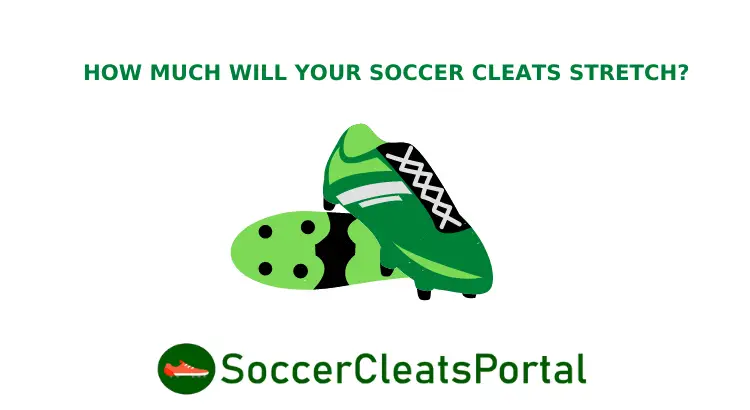Every football boot is going to stretch, which is something that many people don’t consider when getting a brand-new pair of soccer cleats. Even if they’re perfect on your feet, you need to allow for some stretching after a bit of wear.
How much stretching to expect will depend on several factors. The material and the design of a soccer boot are the main factors in how much your soccer cleats will stretch. In general, this will not be more than a few millimeters.
If you don’t consider the stretching, you will end up with the wrong size, even if the boots feel right when they’re brand new. Once you start wearing them and start stretching, some shoes will not feel as good as they did initially.
So with that in mind, here are some tips and some things you should know about how much a given football boot is going to stretch.
How will stretching impact the overall fit of the shoe?
Defining how a football boot is supposed to fit is incredibly difficult as there’s a huge personal preference aspect to the fit. But as a general rule, any new soccer shoe should always feel firm, to begin with. Football boots need to be snug without rubbing or pinching anywhere. They should fit and wrap your foot as closely as possible without being uncomfortable.
The tricky part is how much a football boot will stretch after the breaking-in process or after a few playing sessions. So when you’re trying on a brand new pair of football boots, it’s essential to use your own judgment.
First of all, you need to put them on while standing up and moving around the store. That’s because your feet are going to expand when the weight is on them.
If they feel uncomfortable initially, they are probably not the right product for you. But if they fit a little bit too snugly, that’s probably a good indication. The boots are going to stretch just that little bit, so you will end up with the perfect fit. On the other hand, if you size up and go for a more relaxed fit, you can end up with soccer cleats being too big for you. That’s because you didn’t consider that the boots are going to stretch.
Of course, you also need to consider the material and the overall structure of the shoe.
Which soccer cleats are going to stretch more?
As a general rule of thumb, leather is always going to stretch more than any kind of synthetic or knit material. The reason is that leather is just a more flexible, softer, more pliable, and less structured material.
All materials will typically soften up after some wear time, but stretching is not so much a concern with synthetic boots as it is with leather ones. Overstretching doesn’t tend to happen with synthetic boots as with leather models.
Which part of a soccer cleat will stretch more?
The upper, the part of a soccer cleat that covers the top of your foot, will stretch more. Leather uppers will stretch more than synthetic materials as leather is less structured and softer than most synthetic products.
The plastic soleplate underneath your foot is not going to stretch at all.
Length-wise, you won’t experience as much stretching, and the soleplate shouldn’t stretch at all. Most stretching will occur across the width of the boot.
Some players with really wide feet may experience the upper material spilling over its initial position, so it’s wider than the soleplate. This is generally just something to be aware of if it’s not too severe- but you may need to replace boots more regularly if you have extremely wide feet.
As a general rule of thumb, expect your football boots to stretch in width and not so much in length, whether they’re leather or synthetic.
Will laceless soccer cleats stretch?
Many soccer players are concerned if laceless soccer cleats are going to stretch over time. Because they’re laceless, there is no way to adjust the fit, meaning that if they do stretch, there’s no way to make them fit tighter.
Laceless football boots won’t necessarily stretch out beyond what you see in a laced pair. The critical thing with laceless boots is that they must fit you well from the beginning. With that in mind, even if they stretch, that will not be that significant.
The problem with laceless boots starts if you buy them and they don’t really fit quite right from brand new. As you wear them, it is possible that they’re going to stretch so much to the point where they do not feel secure on your feet.
What to do if soccer cleats stretch?
Now, if your soccer cleats start to overstretch and replacing them is not an option, there are some things that you can do to alleviate the problem.
- Use an extra pair of socks or grip socks.
That will most likely solve the problem by minimizing the extra space inside your shoe.
- Use longer laces.
As we have seen, the shoes will stretch in the upper. By wrapping the boots from the bottom, you will adjust the loose fit on the upper.
- Use ankle braces.
If you have any ankle problems, using ankle braces will help you also diminish the extra space inside the foot.
- Wrap the boot with tape.
That will compress the foot to the shoe and give a slightly better fit.
- Use thicker insoles.
That will eat some space between the bottom of your shoe and the loose upper.
Conclusion
Soccer cleats overstretching is inevitable, and if you don’t plan for this, you could end up with a looser fit and poorer performance as a result.
Hopefully, our tips will help you get rid of that problem for as long as you can.





